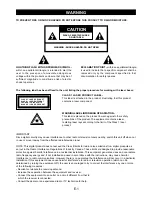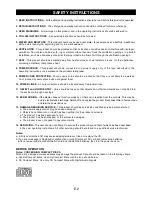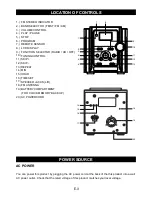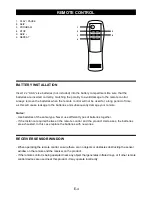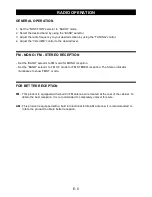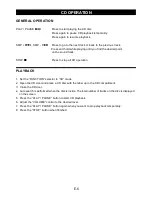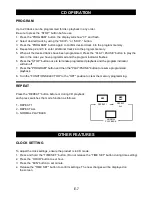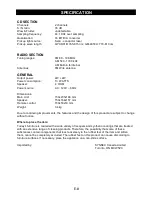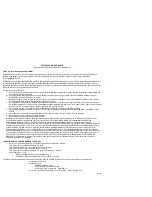
WARNING
E-1
TO PREVENT FIRE OR SHOCK HAZARD DO NOT EXPOSE THIS PRODUCT TO RAIN OR MOISTURE.
WARNING : SHOCK HAZARD-DO NOT OPEN
RISK OF ELECTRIC SHOCK
DO NOT OPEN
CAUTION
LIGHTNING FLASH WITH ARROWHEAD SYMBOL -
within an equilateral triangle, is intended to alert the
user to the presence of uninsulated dangerous
voltage within the products enclosure that may be of
sufficient magnitude to constitude a risk of electric
shock to persons.
EXCLAMATION POINT -
within an equilateral triangle,
is used to indicate that a specific component shall be
replaced only by the component specified in that
documentation for safety reasons.
The following label has been affixed to the unit, listing the proper procedure for working with a laser beam:
CLASS 1 LASER PRODUCT LABEL -
This label is attached to the product, illustrating that this product
contains a laser component.
WARNING LABEL INFORMING OF RADIATION -
This label is placed on the product to warn against other safety
precautions of the product. The equipment contains a laser,
radiating laser rays according to the limit of the Class 1 laser
product.
CLASS 1 LASER PRODUCT
KLASS 1 LASER APPARAT
LUOKEN 1 LAISERLAITE
KLASSE 1 LASER PRODUKT
IMPORTANT
Since digital circuitry may cause interference to other radio or television tuners nearby, switch this unit off when not
in use or move it away from the affected radio/television tuner.
NOTE: This digital product does not exceed the Class B limits for radio noise emissions from digital products as
set out in the Radio Interference Regulations of Industry Canada. These limits are designed to provide reasonable
protection against harmful interference in a residential installation. This equipment generates, uses and can radiate
radio frequency energy and, if not installed and used in accordance with the instructions, may cause harmful
interference to radio communications. However, there is no guarantee that interference will not occur in a particular
installation. If this equipment does cause harmful interference to radio or television operation (which can be
determined by turning the equipment off), the user is encouraged to try to correct the interference by one or more
of the following measures:
• Reorient or relocate the receiving antenna.
• Increase the separation between the equipment and receiver.
• Connect the equipment into an outlet on a circuit different from that to
which the receiver is connected.
• Consult the dealer or an experienced radio / TV technician for help.


